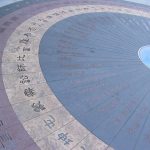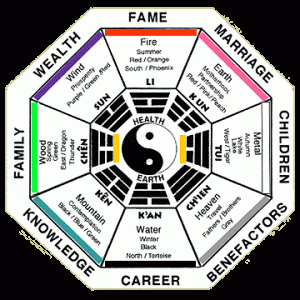Feng Shui (风水) Posted by Stephen on Jan 13, 2012 in Uncategorized
 Feng Shui or 风水 (fēng shuǐ) is an ancient Chinese system of aesthetics believed to use the laws of both Heaven (astronomy) and Earth (geography) to help improve one’s life by receiving positive “qi” (气). Also known as geomancy, this style of Feng Shui is done by reordering and moving furniture, room orientation and even wall/window/door locations to better coincide and synergize with the inhabitants own “life energy”. The original designation for the discipline of Feng Shui is Kan Yu (which translates literally as: Tao of heaven and earth).
Feng Shui or 风水 (fēng shuǐ) is an ancient Chinese system of aesthetics believed to use the laws of both Heaven (astronomy) and Earth (geography) to help improve one’s life by receiving positive “qi” (气). Also known as geomancy, this style of Feng Shui is done by reordering and moving furniture, room orientation and even wall/window/door locations to better coincide and synergize with the inhabitants own “life energy”. The original designation for the discipline of Feng Shui is Kan Yu (which translates literally as: Tao of heaven and earth).
Feng shui improves positive qi simply by rearranging one’s living space to better foster happiness and harmony. While Feng shui doesn’t directly deal with immediate health problems or concerns, much like QiGong (click to here read post on QiGong or 气功), it focuses on long term health and balance of body, mind and spirit.
History (历史)
The history of feng shui dates back 3,500 plus years–even before the invention of the magnetic compass. Feng shui originated from Chinese astronomy and still blends a good deal of astronomical theory with the placement and orientation of one’s living quarters. Some current techniques can be traced to Neolithic China, while others were added later (most notably the Han dynasty, the Tang, the Song, and the Ming).
 The astronomical history of feng shui is evident in the development of instruments and techniques. Rituals for using a feng shui instrument required a diviner to examine current sky phenomena to set and adjust their position in relation to the device. The oldest examples of instruments used for feng shui are liuren astrolabes, also known as shi. These consist of a lacquered, two-sided board with astronomical sightlines (see image to right). The earliest examples of liuren astrolabes have been unearthed from tombs that date between 278 BC and 209 BC.
The astronomical history of feng shui is evident in the development of instruments and techniques. Rituals for using a feng shui instrument required a diviner to examine current sky phenomena to set and adjust their position in relation to the device. The oldest examples of instruments used for feng shui are liuren astrolabes, also known as shi. These consist of a lacquered, two-sided board with astronomical sightlines (see image to right). The earliest examples of liuren astrolabes have been unearthed from tombs that date between 278 BC and 209 BC.
Theory:
The goal of feng shui is to situate the human built environment on spots with good qi. The goal is to find a “perfect spot” in both location and in time. This perfect spot is the intersection of qi (气), polarity (阴阳)and bagua (八卦) or the eight diagrams of cosmology. Since we’ve already covered “qi” and “polarity” (think yin and yang) in previous posts, lets move on directly to the heart of Feng shui–Bagua.
Bagua (八卦)
A bagua map is a tool used in modern forms of feng shui to chart a room or location and see how the different sections of that area correspond to positive or negative aspects in one’s life. These sections are believed to relate to all aspects of life and are divided into such categories as fame, relationships/marriage, children/creativity, advice/travel, career, inner knowledge, family/ancestors/health, and wealth/blessings.
Feng shui became very popular following the conversion of Bagua to the eight aspirations (see above). Each trigram corresponds to an aspect of life which, in its turn, corresponds to one of the cardinal directions. Applying feng shui using the Bagua of the eight aspirations made it possible to simplify feng shui, bringing it within the the reach of the 老百姓 or “everyday folk”. Masters of traditional feng shui call it Neo Feng Shui, for its simplicity, because it does not take into account the forms of the landscape or the temporal influence or the annual cycles. This form of Bagua is simply divided into two branches of a system: cardinal directions, and portal (door/window) orientation to those directions.
In this system, the map is intended to be used over the land, one’s home, office or desk to find areas lacking good chi, and to show where there are negative or missing spaces that may need rectifying or enhancing in life or the environment. A custom made bagua grid is placed over the entire house plan highlighting areas that need improvement to balance your home’s Feng shui.
Follow Steve on Twitter: @seeitbelieveit

Build vocabulary, practice pronunciation, and more with Transparent Language Online. Available anytime, anywhere, on any device.
About the Author: Stephen
Writer and blogger for all things China related. Follow me on twitter: @seeitbelieveit -- My Background: Fluent Mandarin speaker with 3+ years working, living, studying and teaching throughout the mainland. Student of Kung Fu and avid photographer and documentarian.





Leave a comment: